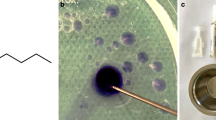Abstract
Background and Purpose
Flow diverter stents (FDSs) are increasingly used for the treatment of intracranial aneurysms. Initially developed for the management of giant and large aneurysms, their indications have progressively expanded. The purpose of our study was to evaluate the safety and effectiveness of FDSs for the treatment of anterior cerebral artery (ACA) aneurysms.
Materials and Methods
Among the 94 consecutive patients treated for 100 intracranial aneurysms by means of FDSs in our institution from October 2010 to January 2015, eight aneurysms (8 %) in seven patients were located on the ACA. Three aneurysms were located on the A1 segment, three aneurysms on the anterior communicating artery (ACom) and two on the A2–A3 junction. In three cases, FDS was used for angiographic recurrence after coiling. Five patients were treated with a Pipeline embolization device, one with a NeuroEndograft and the last one with a Silk FDS.
Results
Treatment was feasible in all cases. No technical difficulty was reported. No acute or delayed clinical complication was recorded. Modified Rankin Scale was 0 for six patients and one for one patient. Mean angiographic follow-up was 9.7 ± 3.9 months (range 6–15).
Total exclusion was observed in five aneurysms (71.4 %) and neck remnant in two (28.6 %) cases. One patient refused the control DSA.
Conclusion
Our series shows the safety and effectiveness of FDSs for the treatment of ACA aneurysms.


Similar content being viewed by others
Abbreviations
- ACA:
-
anterior cerebral artery
- ACom:
-
anterior communicating artery
- DSA:
-
digital subtraction angiography
- FDS:
-
flow diverter stent
- G/LAs:
-
giant/large aneurysms
- IC:
-
intracranial
References
Byrne JV, Beltechi R, Yarnold JA, Birks J, Kamran M. Early experience in the treatment of intra-cranial aneurysms by endovascular flow diversion: a multicentre prospective study. PloS one. 2010;5(9).
Ionita CN, Natarajan SK, Wang W, Hopkins LN, Levy EI, Siddiqui AH, Bednarek DR, Rudin S. Evaluation of a second-generation self-expanding variable-porosity flow diverter in a rabbit elastase aneurysm model. AJNR Am J Neuroradiol. 2011;32(8):1399–407.
Brinjikji W, Murad MH, Lanzino G, Cloft HJ, Kallmes DF. Endovascular treatment of intracranial aneurysms with flow diverters: a meta-analysis. Stroke. 2013;44(2):442–7.
Piotin M, Blanc R, Spelle L, Mounayer C, Piantino R, Schmidt PJ, Moret J. Stent-assisted coiling of intracranial aneurysms: clinical and angiographic results in 216 consecutive aneurysms. Stroke. 2010;41(1):110–5.
Saatci I, Yavuz K, Ozer C, Geyik S, Cekirge HS. Treatment of intracranial aneurysms using the pipeline flow-diverter embolization device: a single-center experience with long-term follow-up results. AJNR Am J Neuroradiol. 2012;33(8):1436–46.
Lanzino G, Crobeddu E, Cloft HJ, Hanel R, Kallmes DF. Efficacy and safety of flow diversion for paraclinoid aneurysms: a matched-pair analysis compared with standard endovascular approaches. AJNR Am J Neuroradiol. 2012;33(11):2158–61.
Fischer S, Vajda Z, Aguilar Perez M, Schmid E, Hopf N, Bäzner H, Henkes H. Pipeline embolization device (PED) for neurovascular reconstruction: initial experience in the treatment of 101 intracranial aneurysms and dissections. Neuroradiology. 2012;54(4):369–82.
Rouchaud A, Saleme S, Gory B, Ayoub D, Mounayer C. Endovascular exclusion of the anterior communicating artery with flow-diverter stents as an emergency treatment for blister-like intracranial aneurysms. A case report. Interv Neuroradiol. 2013;19(4):471–8.
Kamran M, Yarnold J, Grunwald IQ, Byrne JV. Assessment of angiographic outcomes after flow diversion treatment of intracranial aneurysms: a new grading schema. Neuroradiology. 2011;53(7):501–8.
Roy D, Milot G, Raymond J. Endovascular treatment of unruptured aneurysms. Stroke. 2001;32(9):1998–2004.
Tollard E, Niemtschik L, Darsaut TE, Guilbert F, Roy D, Raymond J, Weill A. Endovascular parent artery occlusion for the treatment of wide-neck A1 segment aneurysms: a single-center experience. AJNR Am J Neuroradiol. 2011;32(1):174–8.
Peschillo S, Cannizzaro D, Missori P, Colonnese C, Santodirocco A, Santoro A, Guidetti G. Reconstructive endovascular treatment of a ruptured blood blister-like aneurysm of anterior communicating artery. J Neurosurg Sci. 2014 Jun 10. [Epub ahead of print]
Pistocchi S, Blanc R, Bartolini B, Piotin M. Flow diverters at and beyond the level of the circle of willis for the treatment of intracranial aneurysms. Stroke. 2012;43(4):1032–8.
Gawlitza M, Januel AC, Tall P, Bonneville F, Cognard C. Flow diversion treatment of complex bifurcation aneurysms beyond the circle of Willis: a single-center series with special emphasis on covered cortical branches and perforating arteries. J Neurointerv Surg. 2015 Apr 15. [Epub ahead of print]
Martínez-Galdámez M, Romance A, Vega P, Vega A, Caniego JL, Paul L, Linfante I, Dabus G. Pipeline endovascular device for the treatment of intracranial aneurysms at the level of the circle of Willis and beyond: multicenter experience. J Neurointerv Surg. 2014 Sep 8. [Epub ahead of print]
Piano M, Valvassori L, Quilici L, Pero G, Boccardi E. Midterm and long-term follow-up of cerebral aneurysms treated with flow diverter devices: a single-center experience. J Neurosurg. 2013;118(2):408–16.
Szikora I, Marosfoi M, Salomváry B, Berentei Z, Gubucz I. Resolution of mass effect and compression symptoms following endoluminal flow diversion for the treatment of intracranial aneurysms. AJNR Am J Neuroradiol. 2013;34(5):935–9.
Slater LA, Soufan C, Holt M, Chong W. Effect of flow diversion with silk on aneurysm size: A single center experience. Interv Neuroradiol. 2015;21(1):12–8.
Chalouhi N, Starke RM, Yang S, Bovenzi CD, Tjoumakaris S, Hasan D, Gonzalez LF, Rosenwasser R, Jabbour P. Extending the indications of flow diversion to small, unruptured, saccular aneurysms of the anterior circulation. Stroke. 2014;45(1):54–8.
Conflict of Interest Statement
Dr N.-A. Sourour is proctor for the Pipeline Embolization Device (eV3/Covidien).
Author information
Authors and Affiliations
Corresponding author
Rights and permissions
About this article
Cite this article
Clarençon, F., Di Maria, F., Gabrieli, J. et al. Flow Diverter Stents for the Treatment of Anterior Cerebral Artery Aneurysms: Safety and Effectiveness. Clin Neuroradiol 27, 51–56 (2017). https://doi.org/10.1007/s00062-015-0441-8
Received:
Accepted:
Published:
Issue Date:
DOI: https://doi.org/10.1007/s00062-015-0441-8




